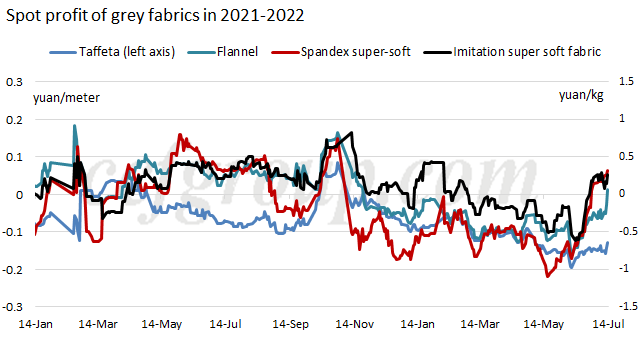Polyester market perceives some positive signals under pessimism
Collapsing polyester feedstock price weighed on the whole value chain recently. High inventory of PFY and fabrics has been obviously depreciated and the operating rate accelerated descending. Sales of fabric have almost been in stagnation when it is during off-season now and feedstock price kept decreasing. Sales of PFY sustained meager and stocks accumulated to yearly high, even higher than the level in 2020 when the pandemic started. Market players lacked confidence.
However, there were some positive signals on the market recently: export orders increased slightly on the month in some regions. The stocks of fabric continued ascending slightly but the accumulation speed slowed down amid low run rate. Price of grey fabrics moved down but the theoretical profit of grey fabrics improved with falling PFY prices, especially DTY. The cash flow of conventional knitted fabrics has been turned to positive territory.

As for downstream business, the orders/sales of grey fabrics in the first half of 2022 was similar to those in 2020 while apparent divergence may appear in the second half of year. Domestic and export demand both rebounded sharply in the second half of 2020. In the first half of 2022, domestic demand rose weakly while export dropped, and overall upward momentum was slow. Jul and Aug are traditional slack season. Demand may not grow much, while speculative demand is likely to improve later if feedstock price stabilizes and demand weakly increases as current PFY stocks are low among downstream plants. We expect it may emerge in end-Jul or Aug and actual demand improvement needs to wait the coming of traditional peak season in Sep and Oct, while the increase in the peak season is likely to be lower than anticipated (high stocks need to be solved and demand may rise limitedly).

Recently, falling polyester polymerization rate was mainly because of plunging operating rate of PFY plants. PFY plants faced high inventory and current stocks have reached the high level in 2020 at the beginning of the pandemic. Meanwhile, the losses expanded. PFY plants sped up to cut production, especially leading companies, which dragged down the operating rate.
The polyester polymerization rate decreased to 76.7% this week after PFY plants scaled down production, hitting yearly low. Among this, the operating rate of direct-spun PFY plants, direct-spun PSF plants and PET bottle chip plants (based on nominal capacity) was at 62.6%, 84.3% and 98.3% respectively. The operating rate of direct-spun PFY companies has gradually matched the run rate of fabric mills (By convention, 50% of fabric mills’ run rate matches 60% of direct-spun PFY plants’ operating rate). Eyes are suggested to the operating rate change of fabric mills later. If fabric mills can sustain 50% of run rate, the production curtailment of PFY plants may be limited. The operating rate of PSF plants was high and whether PSF plants will cut run rate again with weak demand in the future should be concerned. PET bottle chip market saw good operation status and most factories may keep running at full capacity except for some plants scaling down output due to power rationing. The polyester polymerization rate is estimated to be 79% in Jul and at 81% in Aug, with limited recovering space.
- Top keywords
- Cotton Price
- Cotton Futures Price
- Cotton Futures
- CZCE
- PTA Futures Price
- Chemical Fiber
- Polyester Prices
- Wool price
- PTA Futures
- Shengze Silk
- China
- Yarn Price
- price
- China Textile City
- Fibre Price
- Benzene Price
- Cotton
- Index
- Cotton Index
- PTA
- fabric price
- NYMEX
- Top 10
- textile industry
- Spot Cotton
- Cotton Yarn
- Polyester Price
- Futures
- PTA Price
- cotton yarn price

